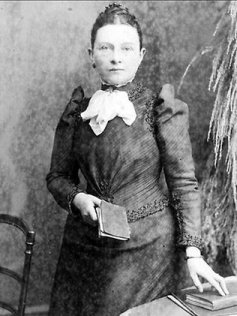 |
Monday, 9 December 2013
Is this Jack the Ripper?
Mood:
 mischievious
Topic: Jack the Ripper mischievious
Topic: Jack the Ripper

Crime writer Patricia Cornwell is promising to publish new research on the identity of Jack the Ripper which she claims will help to solve the mystery. The best-selling author believes she has 'cracked' the case by unearthing evidence that confirms Walter Sickert, an influential artist, as the prime suspect. Fans of the painter were critical of her first book for pointing the finger at the painter, but she has spent the last 11 years working to prove her theory. She says she has a lot more detail and predicts people will be surprised by evidence she has unearthed linking Sickert with the royal family. 'I feel that I have cracked it,' she said. 'I believe it’s Sickert, and I believe it now more than ever.' Furthermore, Ms Cornwell, 47, says the artist had links to the royal family - perhaps backing some kind of royal conspiracy in relation to the crimes. The bestselling author has been working with former Scotland Yard commander John Grieve to look through a selection of letters, held at The National Archives in Kew, allegedly sent to police by the killer. While she admits her evidence is only circumstantial, Ms Cornwell argues it hard to accept it is merely a coincidence watermarks on some of the letters match paper used by Sickert. 'Will we ever prove it? No — how can you? 'It’s a completely circumstantial case with the only real science that we can count on after all these years being the forensic analysis, which is really hard to feel is coincidental when you keep seeing water marks on paper that Jack the Ripper and Sickert had in common.' The author acknowledged that even if the artist wrote some of the letters, it does not mean Sickert was the killer. However, she added: 'In court, a jury might struggle with that. They are very confessional and violent letters.' The writer has spent millions of pounds investigating the unidentified killer - who killed at least five prostitutes in Whitechapel in the late 1880s. Read more: dailymail.co.uk
Posted by Neil Bartlett DHyp M.A.E.P.H
at 00:01 CET
Updated: Monday, 9 December 2013 01:45 CET
Monday, 14 May 2012
Author claims Jack the Ripper was a WOMAN
Mood:
 cheeky
Topic: Jack the Ripper cheeky
Topic: Jack the Ripper
A BIRMINGHAM author has caused a storm among historians by claiming Jack the Ripper was a WOMAN.
Former solicitor John Morris, 62, has named Welsh-born Lizzie Williams as the Whitechapel monster – and claims she killed her victims because she could not have children. Lizzie was wife of royal physician Sir John Williams, himself seen as a prime suspect by many other crime experts. John’s new book, Jack the Ripper: The Hand of a Woman, was written along with his late father Byron. The men sifted through thousands of medical and legal documents to draw-up a compelling case for branding Lizzie the killer. Full Story from birminghammail.net
Posted by Neil Bartlett DHyp M.A.E.P.H
at 01:01 MEST
Updated: Monday, 14 May 2012 02:02 MEST
Wednesday, 9 November 2011
Is this the knife Jack the Ripper used to disembowel?
Mood:
 d'oh
Topic: Jack the Ripper d'oh
Topic: Jack the Ripper
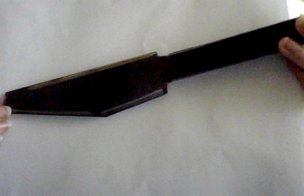
Pictured for the first time - this newly-discovered knife could be one of the most infamous murder weapons in British criminal history. The razor sharp six-inch blade belonged to Welsh surgeon Sir John Williams, a chief suspect in the notorious Jack the Ripper murders. Sir John - known to his family at the time of the killings as 'Uncle Jack' - was the surgeon to Queen Victoria who lived in London at the time of the slayings. He fled the capital after the murders and later founded the National Library for Wales in Aberystwyth. One of his distant relatives has now unearthed the old black-handled surgeon's knife, which he used for operations, and is sure it is the murder weapon. Full Story from dailymail.co.uk
Posted by Neil Bartlett DHyp M.A.E.P.H
at 01:01 CET
Updated: Wednesday, 9 November 2011 16:50 CET
Thursday, 15 September 2011
Is this the face of Jack the Ripper?
Mood:
 a-ok
Topic: Jack the Ripper a-ok
Topic: Jack the Ripper
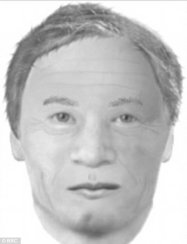
Thin-haired with a large nose and deep-set eyes, it is the unremarkable face of a man who may be the most notorious murderer in history. Astonishingly, it is also the first time anyone has attempted to put together an e-fit of Carl Feigenbaum, one of the men most likely to be Jack the Ripper. The 54-year-old German merchant seaman went to the electric chair in New York in 1894 after the brutal murder of his landlady Juliana Hoffman. A psychopath with a self-confessed penchant for mutilating women, even his own lawyer believed he was the Ripper. Full Story from dailymail.co.uk
Posted by Neil Bartlett DHyp M.A.E.P.H
at 11:54 MEST
Wednesday, 10 August 2011
Chief Inspector Abberline named as Jack the Ripper
Mood:
 bright
Topic: Jack the Ripper bright
Topic: Jack the Ripper
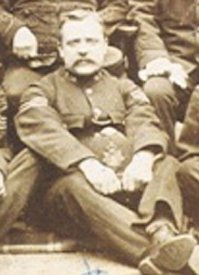
Suspects have ranged from a member of Royal Family to a local butcher – but it is now claimed that Jack the Ripper was the very detective who led the hunt for the killer. Chief Inspector Frederick Abberline of Scotland Yard was the man who murdered and mutilated at least five women in Victorian East London – at least according to Spanish writer Jose Luis Abad, 84. He makes the claim in his book Jack the Ripper: The Most Intelligent Murderer in History, published in Spain this week. Full Story from dailymail.com
Posted by Neil Bartlett DHyp M.A.E.P.H
at 09:13 MEST
Sunday, 17 April 2011
Jack the Ripper was a German sailor, detective claims
Mood:
 bright
Topic: Jack the Ripper bright
Topic: Jack the Ripper

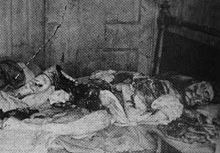
Jack the Ripper was probably a German merchant seaman named Carl Feigenbaum. That’s the theory proposed by English former murder squad detective Trevor Marriott. He spoke to The Local. They are history’s most notorious serial murders and among the world's most famous unsolved crimes. Between August and November 1888, five prostitutes were killed and horribly mutilated in and around London’s crowded, impoverished Whitechapel area. Mary Ann Nichols, Annie Chapman, Elizabeth Stride, Catherine Eddowes and Mary Jane Kelly had their throats slashed and – with the exception of Stride – their abdomens mutilated. Then the killings stopped abruptly. The murderer was never identified. And the Jack the Ripper phenomenon began. Full Story from thelocal.de
Posted by Neil Bartlett DHyp M.A.E.P.H
at 11:44 MEST
Tuesday, 24 November 2009
Jack the Rippers 5th victim, Mary Jane Kelly
Mood:
 d'oh
Topic: Jack the Ripper d'oh
Topic: Jack the Ripper
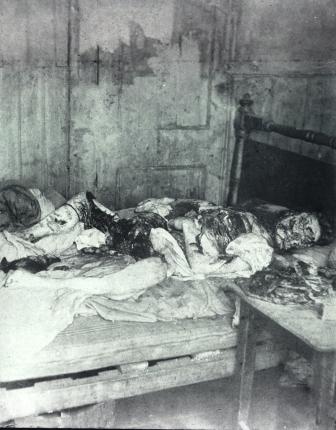
On the morning of 9 November 1888, the day of the annual Lord Mayor's Day celebrations, Kelly's landlord John McCarthy sent his assistant, Thomas Bowyer, to collect the rent. Kelly was several weeks behind on her payments. Bowyer knocked on her door but received no response. He reached through a crack in a window and pushed aside a coat being used as a curtain and peered inside. What he discovered was a horribly mutilated corpse.
Kelly's body was discovered shortly after 10:45 am. Her body was found lying on the bed in the single room where she lived at 13 Miller's Court, off Dorset Street in Spitalfields, London. Neighbours' reports of hearing a solitary scream in the night suggested she may have been killed sometime around 4:00 am. Reports have it that a woman was heard to shout simply: 'Murder!'
The Manchester Guardian of 10 November 1888 reported that Sgt Edward Badham accompanied Inspector Walter Beck to the site of 13 Miller's Court after they were both notified of the murder of Mary Kelly by a frantic Thomas Bowyer. It is generally accepted that Beck was the first police official to arrive at the Kelly crime scene and Badham is believed to have accompanied him, but there are no official records to confirm Badham being with him.
A woman named Caroline Maxwell claimed to have seen Kelly alive at about 08:30 on the morning after the murder, though she admitted to only meeting her once or twice before; moreover, her description did not match that of those who knew Kelly more closely. Maurice Lewis, a tailor, reported seeing Kelly at about 10:00 that same morning in a pub. Both statements were dismissed by the police since they did not fit the accepted time of death; moreover, they could find no one else to confirm the reports. This contradiction was used as a plot device in the graphic novel From Hell (and subsequent movie adaptation) in which someone else is mistaken for Kelly and murdered in her place.
Edward Badham was also on duty at Commercial Street police station on the evening of 12 November 1888. The inquest into the death of Mary Kelly had been completed earlier that day, when around 6 pm, a man named George Hutchinson arrived at the station claiming he had seen Kelly with a man of 'respectable appearance' on the night of her death. Badham took Hutchinson's initial statement that evening. 
Dr. Thomas Bond, a police surgeon from A Division, was called in on the Mary Kelly murder. His notes read as follows:
"The body was lying naked in the middle of the bed, the shoulders flat but the axis of the body inclined to the left side of the bed. The head was turned on the left cheek. The left arm was close to the body with the forearm flexed at a right angle and lying across the abdomen.
The right arm was slightly abducted from the body and rested on the mattress. The elbow was bent, the forearm supine with the fingers clenched. The legs were wide apart, the left thigh at right angles to the trunk and the right forming an obtuse angle with the pubes.
The whole of the surface of the abdomen and thighs was removed and the abdominal cavity emptied of its viscera. The breasts were cut off, the arms mutilated by several jagged wounds and the face hacked beyond recognition of the features. The tissues of the neck were severed all round down to the bone.
The viscera were found in various parts viz: the uterus and kidneys with one breast under the head, the other breast by the right foot, the liver between the feet, the intestines by the right side and the spleen by the left side of the body. The flaps removed from the abdomen and thighs were on a table.
The bed clothing at the right corner was saturated with blood, and on the floor beneath was a pool of blood covering about two feet square. The wall by the right side of the bed and in a line with the neck was marked by blood which had struck it in a number of separate splashes.
The face was gashed in all directions, the nose, cheeks, eyebrows, and ears being partly removed. The lips were blanched and cut by several incisions running obliquely down to the chin. There were also numerous cuts extending irregularly across all the features.
The neck was cut through the skin and other tissues right down to the vertebrae, the fifth and sixth being deeply notched. The skin cuts in the front of the neck showed distinct ecchymosis. The air passage was cut at the lower part of the larynx through the cricoid cartilage.
Both breasts were more or less removed by circular incisions, the muscle down to the ribs being attached to the breasts. The intercostals between the fourth, fifth, and sixth ribs were cut through and the contents of the thorax visible through the openings.
The skin and tissues of the abdomen from the costal arch to the pubes were removed in three large flaps. The right thigh was denuded in front to the bone, the flap of skin, including the external organs of generation, and part of the right buttock. The left thigh was stripped of skin fascia, and muscles as far as the knee.
The left calf showed a long gash through skin and tissues to the deep muscles and reaching from the knee to five inches above the ankle. Both arms and forearms had extensive jagged wounds.
The right thumb showed a small superficial incision about one inch long, with extravasation of blood in the skin, and there were several abrasions on the back of the hand moreover showing the same condition.
On opening the thorax it was found that the right lung was minimally adherent by old firm adhesions. The lower part of the lung was broken and torn away. The left lung was intact. It was adherent at the apex and there were a few adhesions over the side. In the substances of the lung there were several nodules of consolidation.
The pericardium was open below and the heart absent. In the abdominal cavity there was some partly digested food of fish and potatoes, and similar food was found in the remains of the stomach attached to the intestines."
Dr Bond also stated that the knife used was about an inch wide and at least six inches long, but did not believe that the murderer had any medical training or knowledge. In his report he concluded
In each case the mutilation was inflicted by a person who had no scientific nor anatomical knowledge. In my opinion he does not even possess the technical knowledge of a butcher of horse slaughterer or a person accustomed to cut up dead animals.
Posted by Neil Bartlett DHyp M.A.E.P.H
at 18:49 CET
Updated: Tuesday, 24 November 2009 19:00 CET
Jack the Rippers 4th victim Catherine Eddowes
Mood:
 a-ok
Topic: Jack the Ripper a-ok
Topic: Jack the Ripper
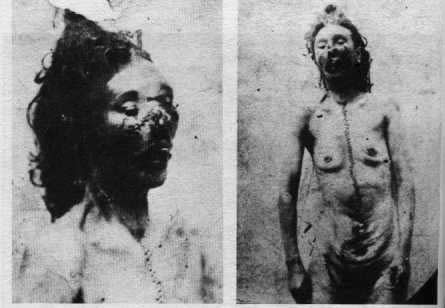
At 8.30 pm on Saturday the 29th September Eddowes was found lying in the road drunk on Aldgate High Street by PC Louis Robinson and taken into custody at Bishopsgate police station. She was detained here until 1am on the morning of the 30th and then released. On leaving the station she turned left in the direction of Aldgate- rather than turning right to take the shortest route to her home at Flower and Dean Street. She was last seen alive by three witnesses, Joseph Lawende, Joseph Hyam Levy and Harry Harris, standing talking with a man (presumably her killer) at the entrance to Church Passage (which leads west to Mitre Square) at 1.35am. Only ten minutes later (1.45am) her horribly mutilated body was found in the south corner of Mitre Square by PC Edward Watkins on his beat.
Though this murder occurred within the City of London, it was close to the boundary of Whitechapel where the previous murders in the series had occurred. The ghastly mutiliation of Eddowes' body and the abstraction of her left kidney and part of her womb by her murderer bore the signature of 'Jack the Ripper', and was very similar in nature to that of earlier Whitechapel murder victims Annie Chapman and Mary Ann Nichols.
Due to the location of this murder the City Police under Detective Inspector James McWilliam were engaged in the murder enquiry, joining the Metropolitan Police who had been engaged in the previous Whitechapel murders. At 3am on the same day as she was murdered a blood-stained fragment of Eddowe's apron was found lying in the passage of the doorway leading to 108 to 119 Model dwellings Goulston Street, Whitechapel. Above it on the wall was a graffito inscribed: "The Juews are the men that will not be blamed for nothing".
On October 16th 1888 half a human kidney wrapped in a letter "From Hell" was received by George Lusk, Chairman of the Whitechapel Vigilance Committee:
“ From hell.
Mr Lusk,
Sor
I send you half the Kidne I took from one women prasarved it for you tother piece I fried and ate it was very nise. I may send you the bloody knif that took it out if you only wate a whil longer
signed
Catch me when you can Mishter Lusk ”
Posted by Neil Bartlett DHyp M.A.E.P.H
at 01:08 CET
Updated: Tuesday, 24 November 2009 01:14 CET
Jack the Rippers 3rd victim, Elizabeth Stride
Mood:
 chatty
Topic: Jack the Ripper chatty
Topic: Jack the Ripper
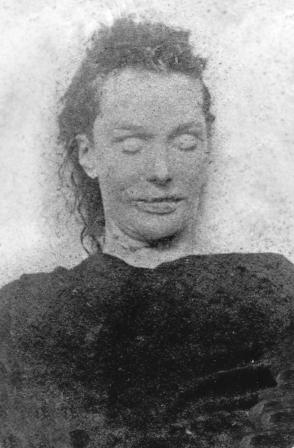
by Georgi DagnallIn 1888, Henriques Street was called Berner Street. On the west side of this street was a set of buildings clustered around a small open area called Dutfield's Yard, named after the man who used to own a cart building business in this area. The yard itself consisted of a U-shaped collection of narrow buildings surrounding a dark, narrow passageway on three sides. The only way that you could enter the yard without passing through a crowded building was through the yard's entrance to the street on the east. Most of the narrow buildings that framed the yard were small cottages. There was a larger building on the north side next to the yard entrance which was the meeting place of the International Working Men's Club. This was the location of the forth murder.
On Saturday, September 29, the club held a meeting with lectures. After the lectures, about a dozen people were still mingling in the club while several people were singing songs. At least three people left the club for a short walk in the yard between the hours of midnight and 1:00 AM, with the last person seeing nothing out of the ordinary at 12:40 AM.
When Louis Diemschutz, the steward of the International Working Men's Club, tried to enter the yard with his wagon at 1:00 AM, his pony with its much better eyesight refused to walk on the right side of the drive. Diemschutz struck a match and saw the figure of a woman lying on the ground next to the wall of the club. He went inside the club to get a candle and people to help him. They found that the woman's throat had been cut, and that blood was still flowing from the wound. The arrival of Diemschutz and his cart might have forced the murderer to flee. The police, who were heavily patrolling the East End area, arrived within minutes. The police doctor, Dr. Blackwell, arrived at 1:16 AM.
What was unusual about the condition of this body compared to the other murders is that the throat had been slit only on the left side. A single slice cut neatly through the major arteries and completely severed the windpipe. The victim had some unusual bruising on her front shoulders, as if two hands had forcibly held her down. This type of bruising was not seen on the other victims. Like the other victims, this woman had very little blood on her, suggesting that her throat had been cut while she was lying or being placed on the ground.
Other than the violent slash to the throat, the state of the body indicated a peaceful death. As opposed to the other victims, who had looked as though they had been strangled before having their throats slit, the face of this victim was quite placid and unmarked. She likely passed out from loss of blood before she died. It looked to those who viewed the body as if the woman had been gently laid on her left side on the muddy ground. Her face pointed at the wall of the club and her left hand still held a packet of cachous, a kind of 19th century breath mint. Her right hand was over her body and was stained with blood. Her feet were tucked up to her body and were just a few steps from the street entrance. The autopsy showed no indication of drugs or alcohol that might have stupefied her and made it easy for the killer to subdue her.
The police identified the victim as a Swedish woman named Elizabeth Stride, also known as Long Liz. She was 44 years old, 5 feet 2 inches or 1.6 meters tall with dark brown curly hair, gray eyes and was missing her upper front teeth. She was a well-liked, well-mannered charwoman and occasional prostitute. At least, she was well mannered when she hadn't been drinking. By the time she was 21, she was known to Swedish police as a prostitute and had already been treated twice for venereal disease.
Several witnesses spotted Liz walking with a man in the area where her body was found. One witness was a police constable walking his beat at 12:30 AM, half an hour before her body was found. He passed the couple and got a good look at the woman, whom he later identified as the murder victim. His description of the man was that he was approximately 28 years old, 5 feet 7 inches or 1.7 meters tall, respectable looking with a dark complexion and a small dark mustache. He carried a parcel that was about 18 inches or 45 cm long and 6 inches or 15 centimeters wide. He was dressed in a hard felt deerstalker hat of dark color, a white collar and tie and a black coat. To the officer, the couple looked sober...
Posted by Neil Bartlett DHyp M.A.E.P.H
at 00:45 CET
Updated: Tuesday, 24 November 2009 18:59 CET
Jack the Rippers 2nd victim, Annie Chapman
Mood:
 cool
Topic: Jack the Ripper cool
Topic: Jack the Ripper

by Georgi DagnallJust after midnight on Saturday, September 8, 1888, Dark Annie was enjoying herself in the warmth of the kitchen of her boarding house. At 1:40 AM, she was thrown out because she had no money to pay for a bed. She was well aware that Polly Nichols had been brutally murdered slightly more than a week before. But Annie was feeling ill and didn't want to wander the streets all night. She would get some money and be back. As she walked away from the boarding house into the dark night, not drunk but slightly tipsy, she had no idea that her body would be found 1000 feet or 400 meters away just four hours later, in the back yard of number 29 Hanbury Street.
Both the time of death and the location depict a brazen killer. The backyard was completely surrounded on three sides by a high wooden fence. Dark Annie and her killer most likely let themselves in through the unlocked front door, sneaked though the passageway of the house and exited to the yard by the back door. Once inside the yard, the killer murdered her, most likely by strangling her and slitting her throat. He then mutilated her body ... under the windows of at least 5 different tenants. If this murder took place in the early dawn hours, not only would the killer and his victim have been visible to anyone looking out of the windows of the house, but they would have been visible to people looking out of some of the windows of the neighboring houses as well. The killer could easily have been trapped in the yard with his only escape through the front door of the house or over the five-foot (or one and a half meter) wooden fence.
One of the biggest legends of Jack the Ripper began with this crime scene. Some researchers are certain that Jack's murders have the marks of a Masonic ritual. Close to the feet and head of the dead woman were the few trinkets and possessions that she had carried with her. They were arranged carefully, not dropped or scattered. Unfortunately, we don't know the exact placement of the objects because police procedures at the time didn't include the new art of photography. From the notes of the police on the scene, the killer had arranged a small piece of fabric, a comb and another pocket comb in a paper case between her feet and the fence. Near her head was a portion of an envelope that contained two pills. Annie was in the habit of wearing some brass rings, which were missing from the body. The police searched local pawn shops but never found the rings. Some researchers have claimed that a few coins were found with the victim. The reports that survived to our modern day don't mention any coins.
A detailed examination of the body took place in the mortuary that afternoon. Dr. Phillips believed that the victim had been partially strangled before her death. The cut to the throat had been so deep that the head was almost completely cut off. The killer sliced open the abdomen and then lifted the intestines out and over the victim's shoulder. He then cut out the uterus, the upper portion of the vagina and two-thirds of the bladder. Since these organs were not found at the crime scene, the killer probably took them with him.
The doctor believed that a professional with some knowledge of anatomy, either a doctor or a person who worked in a slaughterhouse, might have performed the cuts to the abdomen using a single thin sharp knife with a blade six to eight inches or 15 to 20 cm in length. This type of knife was used by a doctor for amputations or by a slaughter man for butchering animals. Dr. Phillips estimated that it would have taken a trained doctor with over 20 years of experience almost an hour to perform a similar dissection.
Posted by Neil Bartlett DHyp M.A.E.P.H
at 00:32 CET
Updated: Tuesday, 24 November 2009 01:16 CET
Newer | Latest | Older
|
| « |
April 2024 |
» |
 |
| S |
M |
T |
W |
T |
F |
S |
|
1 |
2 |
3 |
4 |
5 |
6 |
| 7 |
8 |
9 |
10 |
11 |
12 |
13 |
| 14 |
15 |
16 |
17 |
18 |
19 |
20 |
| 21 |
22 |
23 |
24 |
25 |
26 |
27 |
| 28 |
29 |
30 |
|



